MYSOLUTIONS
I have solutions for the following subjects:
Nursing, Business, Accounting, statistics, chemistry, Biology, and all other subjects
Nursing Being my main profession line, I have essential guides that are Almost A+ graded, I am a very friendly person: If you don't not agree with my solutions I am ready for a refund.
- 1801
- 0
- 24
Community
- Followers
- Following
1825 items
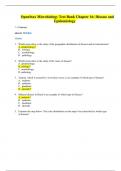
OpenStax Microbiology Test Bank Chapter 16: Disease and Epidemiology * = Correct answer
OpenStax Microbiology Test Bank Chapter 16: Disease and Epidemiology * = Correct answer Multiple Choice 1. Which term refers to the study of the geographic distribution of disease and its transmission? A. epidemiology* B. etiology C. morbidology D. pathology 2. Which term refers to the study of the cause of disease? A. epidemiology B. etiology* C. morbidology D. pathology 3. Tetanus, which is caused by Clostridium tetani, is an example of which type of disease? A. endemic B. ep...
- Exam (elaborations)
- • 13 pages •
OpenStax Microbiology Test Bank Chapter 16: Disease and Epidemiology * = Correct answer Multiple Choice 1. Which term refers to the study of the geographic distribution of disease and its transmission? A. epidemiology* B. etiology C. morbidology D. pathology 2. Which term refers to the study of the cause of disease? A. epidemiology B. etiology* C. morbidology D. pathology 3. Tetanus, which is caused by Clostridium tetani, is an example of which type of disease? A. endemic B. ep...
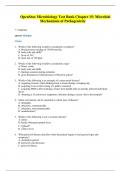
OpenStax Microbiology Test Bank Chapter 15: Microbial Mechanisms of Pathogenicity
OpenStax Microbiology Test Bank Chapter 15: Microbial Mechanisms of Pathogenicity * = Correct answer Multiple Choice 1. Which of the following would be considered a symptom? A. blood pressure reading of 150/90 mm Hg B. body ache and chills* C. fever of 39 C D. heart rate of 120 bpm 2. Which of the following would be considered a sign? A. blurry vision B. body ache and chills C. burning sensation during urination D. gross hematuria (visible presence of blood in urine)* 3. W...
- Exam (elaborations)
- • 16 pages •
OpenStax Microbiology Test Bank Chapter 15: Microbial Mechanisms of Pathogenicity * = Correct answer Multiple Choice 1. Which of the following would be considered a symptom? A. blood pressure reading of 150/90 mm Hg B. body ache and chills* C. fever of 39 C D. heart rate of 120 bpm 2. Which of the following would be considered a sign? A. blurry vision B. body ache and chills C. burning sensation during urination D. gross hematuria (visible presence of blood in urine)* 3. W...
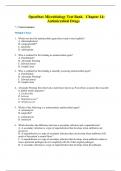
OpenStax Microbiology Test Bank Chapter 14: Antimicrobial Drugs
OpenStax Microbiology Test Bank Chapter 14: Antimicrobial Drugs * = Correct answer Multiple Choice 1. Which was the first antimicrobial agent discovered to treat syphilis? A. chloramphenicol B. compound 606* C. penicillin D. sulfonamide 2. Who is credited for first finding an antimicrobial agent? A. Paul Ehrlich* B. Alexander Fleming C. Edward Jenner D. Joseph Lister 3. Who is credited for first finding a naturally occurring antimicrobial agent? A. Paul Ehrlich B. Alexa...
- Exam (elaborations)
- • 17 pages •
OpenStax Microbiology Test Bank Chapter 14: Antimicrobial Drugs * = Correct answer Multiple Choice 1. Which was the first antimicrobial agent discovered to treat syphilis? A. chloramphenicol B. compound 606* C. penicillin D. sulfonamide 2. Who is credited for first finding an antimicrobial agent? A. Paul Ehrlich* B. Alexander Fleming C. Edward Jenner D. Joseph Lister 3. Who is credited for first finding a naturally occurring antimicrobial agent? A. Paul Ehrlich B. Alexa...
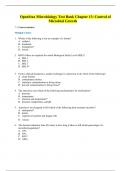
OpenStax Microbiology Test Bank Chapter 13: Control of Microbial Growth
OpenStax Microbiology Test Bank Chapter 13: Control of Microbial Growth * = Correct answer Multiple Choice 1. Which of the following is not an example of a fomite? A. catheter B. doorknob C. mosquitoes* D. towels 2. HEPA filters are required for which Biological Safety Level (BSL)? A. BSL 1 B. BSL 2 C. BSL 3 D. BSL 4* 3. From a clinical perspective, aseptic technique is carried out to do which of the following? A. clean fomites B. contaminate fomites C. introduce co...
- Exam (elaborations)
- • 13 pages •
OpenStax Microbiology Test Bank Chapter 13: Control of Microbial Growth * = Correct answer Multiple Choice 1. Which of the following is not an example of a fomite? A. catheter B. doorknob C. mosquitoes* D. towels 2. HEPA filters are required for which Biological Safety Level (BSL)? A. BSL 1 B. BSL 2 C. BSL 3 D. BSL 4* 3. From a clinical perspective, aseptic technique is carried out to do which of the following? A. clean fomites B. contaminate fomites C. introduce co...

OpenStax Microbiology Test Bank Chapter 12: Modern Applications of Microbial Genetics
OpenStax Microbiology Test Bank Chapter 12: Modern Applications of Microbial Genetics * = Correct answer Multiple Choice 1. Which of the following is the definition of biotechnology? A. The alteration of DNA in a cell B. The use of living systems to benefit humankind* C. Using computers to synthesize biomolecules D. Using DNA for solving mathematical problems 2. Which of the following is the definition of genetic engineering? A. The alteration of DNA in a cell* B. The use of livin...
- Exam (elaborations)
- • 12 pages •
OpenStax Microbiology Test Bank Chapter 12: Modern Applications of Microbial Genetics * = Correct answer Multiple Choice 1. Which of the following is the definition of biotechnology? A. The alteration of DNA in a cell B. The use of living systems to benefit humankind* C. Using computers to synthesize biomolecules D. Using DNA for solving mathematical problems 2. Which of the following is the definition of genetic engineering? A. The alteration of DNA in a cell* B. The use of livin...
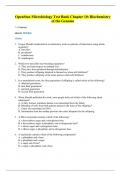
OpenStax Microbiology Test Bank Chapter 10: Biochemistry of the Genome
OpenStax Microbiology Test Bank Chapter 10: Biochemistry of the Genome * = Correct answer Multiple Choice 1. Gregor Mendel conducted his revolutionary work on patterns of inheritance using which organism? A. fruit flies B. pea plants* C. roundworms D. snapdragons 2. Which best describes true-breeding organisms? A. They are heterozygous at multiple loci. B. They have been produced through hybridization. C. They produce offspring identical to themselves when self-fertilized.* D. The...
- Exam (elaborations)
- • 13 pages •
OpenStax Microbiology Test Bank Chapter 10: Biochemistry of the Genome * = Correct answer Multiple Choice 1. Gregor Mendel conducted his revolutionary work on patterns of inheritance using which organism? A. fruit flies B. pea plants* C. roundworms D. snapdragons 2. Which best describes true-breeding organisms? A. They are heterozygous at multiple loci. B. They have been produced through hybridization. C. They produce offspring identical to themselves when self-fertilized.* D. The...
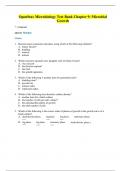
OpenStax Microbiology Test Bank Chapter 9: Microbial Growth
OpenStax Microbiology Test Bank Chapter 9: Microbial Growth * = Correct answer Multiple Choice 1. Bacteria most commonly reproduce using which of the following methods? A. binary fission* B. budding C. meiosis D. mitosis 2. Which structure separates new daughter cells in binary fission? A. the crescent B. the division septum* C. the FtsZ D. the spindle apparatus 3. Which of the following is another term for generation time? A. doubling time* B. growth rate C. mitotic index ...
- Exam (elaborations)
- • 13 pages •
OpenStax Microbiology Test Bank Chapter 9: Microbial Growth * = Correct answer Multiple Choice 1. Bacteria most commonly reproduce using which of the following methods? A. binary fission* B. budding C. meiosis D. mitosis 2. Which structure separates new daughter cells in binary fission? A. the crescent B. the division septum* C. the FtsZ D. the spindle apparatus 3. Which of the following is another term for generation time? A. doubling time* B. growth rate C. mitotic index ...
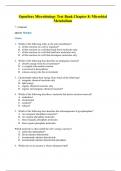
OpenStax Microbiology Test Bank Chapter 8: Microbial Metabolism
OpenStax Microbiology Test Bank Chapter 8: Microbial Metabolism * = Correct answer Multiple Choice 1. Which of the following refers to the term metabolism? A. all the reactions in a cell or organism* B. all the reactions in a cell that break down molecules only C. all the reactions in a cell that build new molecules only D. all the reactions in a cell that decompose molecules only 2. Which of the following best describes an endergonic reaction? A. absorbs energy from the environment*...
- Exam (elaborations)
- • 12 pages •
OpenStax Microbiology Test Bank Chapter 8: Microbial Metabolism * = Correct answer Multiple Choice 1. Which of the following refers to the term metabolism? A. all the reactions in a cell or organism* B. all the reactions in a cell that break down molecules only C. all the reactions in a cell that build new molecules only D. all the reactions in a cell that decompose molecules only 2. Which of the following best describes an endergonic reaction? A. absorbs energy from the environment*...
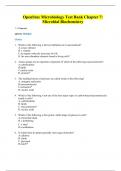
OpenStax Microbiology Test Bank Chapter 7: Microbial Biochemistry
OpenStax Microbiology Test Bank Chapter 7: Microbial Biochemistry * = Correct answer Multiple Choice 1. Which of the following is the best definition of a macronutrient? A.a trace element B. a vitamin C. an organic molecule necessary for life D. the most abundant elements found in living cells* 2. Amino groups are an important component of which of the following macromolecules? A.carbohydrates B.lipids C.nucleic acids D. proteins* 3. The building blocks of polymers are called whi...
- Exam (elaborations)
- • 15 pages •
OpenStax Microbiology Test Bank Chapter 7: Microbial Biochemistry * = Correct answer Multiple Choice 1. Which of the following is the best definition of a macronutrient? A.a trace element B. a vitamin C. an organic molecule necessary for life D. the most abundant elements found in living cells* 2. Amino groups are an important component of which of the following macromolecules? A.carbohydrates B.lipids C.nucleic acids D. proteins* 3. The building blocks of polymers are called whi...
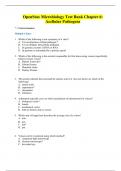
OpenStax Microbiology Test Bank Chapter 6: Acellular Pathogens
OpenStax Microbiology Test Bank Chapter 6: Acellular Pathogens * = Correct answer Multiple Choice 1. Which of the following is not a property of a virus? A. It is an infectious cellular pathogen.* B. It is an obligate intracellular pathogen. C. Its genome consists of DNA or RNA. D. Its genome is surrounded by a protein capsid. 2. Which of the following is the scientist responsible for first discovering viruses (specifically, tobacco mosaic virus)? A. Dimitri Ivanovski* B. Edward Jen...
- Exam (elaborations)
- • 14 pages •
OpenStax Microbiology Test Bank Chapter 6: Acellular Pathogens * = Correct answer Multiple Choice 1. Which of the following is not a property of a virus? A. It is an infectious cellular pathogen.* B. It is an obligate intracellular pathogen. C. Its genome consists of DNA or RNA. D. Its genome is surrounded by a protein capsid. 2. Which of the following is the scientist responsible for first discovering viruses (specifically, tobacco mosaic virus)? A. Dimitri Ivanovski* B. Edward Jen...
